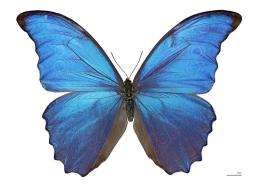February 13, 2012 report
Researchers make better heat sensor based on butterfly wings

(PhysOrg.com) -- Scientists have long known that butterfly wings produce their iridescent colors by bouncing light around and between tiny ridges in structures made of chitin. More recently they’ve discovered that the chitin material in their wings also expands when struck by infrared radiation which causes a change in its refraction index, converting it to visible light. Now, by adding a layer of carbon nanotubes to the wing material, the researchers have found they are able to increase the amount of heat absorbed. This discovery, the team writes in their paper published in Nature Photonics, could lead to new kinds of thermal imaging systems.
In their study, the team used the Morpho sulkowsky butterfly, a native of South America, a species known for its iridescence. It, like most butterflies, has wings that are made up of thousands of tiny tree-like structures made of chitin. When light strikes the branches and folds of the nanosized structures, it’s bounced around causing a multitude of reflections and refractions, partly accounting for the coloring that we see when looking at them. The other part is caused by the chitin expanding (changing its refraction index) when exposed to infrared radiation, which is subsequently converted to visible light. The chitin expands by actually absorbing the infrared light, a property that is of special interest to the team of researchers at General Electric’s Global Research Center; a group who has found they can increase the heat absorption of the chitin by adding a layer of carbon nanotubes. In so doing they discovered the resultant product could sense temperature differences as small as 0.018 °C.
Thermal imaging systems are used in night vision goggles to help people see in the dark and in many other devices such as those that detect heat loss from buildings. As more sensitive devices are made, higher resolutions can be had which could lead to sensors able to detect medical conditions earlier, or problems with mechanical machinery. If this new method using fabricated butterfly wings and nanotubes pans out, it would also vastly reduce the cost associated with manufacturing such devices because it would do away with such components as heat sinks and the need to fabricate other micro-components.
More information: Towards high-speed imaging of infrared photons with bio-inspired nanoarchitectures, Nature Photonics (2012) doi:10.1038/nphoton.2011.355
Abstract
Existing infrared detectors rely on complex microfabrication and thermal management methods. Here, we report an attractive platform of low-thermal-mass resonators inspired by the architectures of iridescent Morpho butterfly scales. In these resonators, the optical cavity is modulated by its thermal expansion and refractive index change, resulting in ‘wavelength conversion’ of mid-wave infrared (3–8 µm) radiation into visible iridescence changes. By doping Morpho butterfly scales with single-walled carbon nanotubes, we achieved mid-wave infrared detection with 18–62 mK noise-equivalent temperature difference and 35–40 Hz heat-sink-free response speed. The nanoscale pitch and the extremely small thermal mass of individual ‘pixels’ promise significant improvements over existing detectors. Computational analysis explains the origin of this thermal response and guides future conceptually new bio-inspired thermal imaging sensor designs.
Journal information: Nature Photonics
© 2011 PhysOrg.com



















